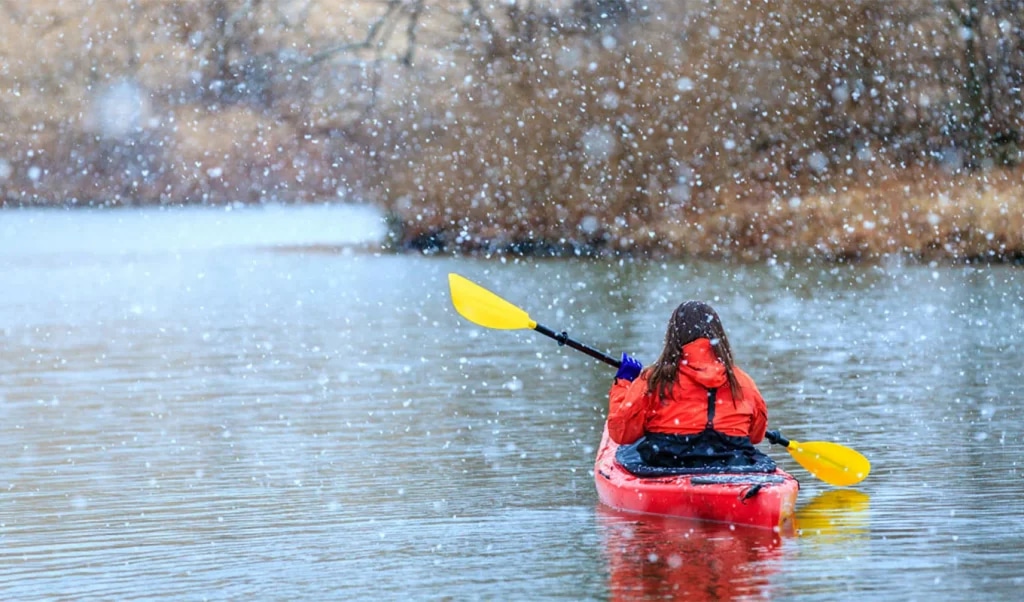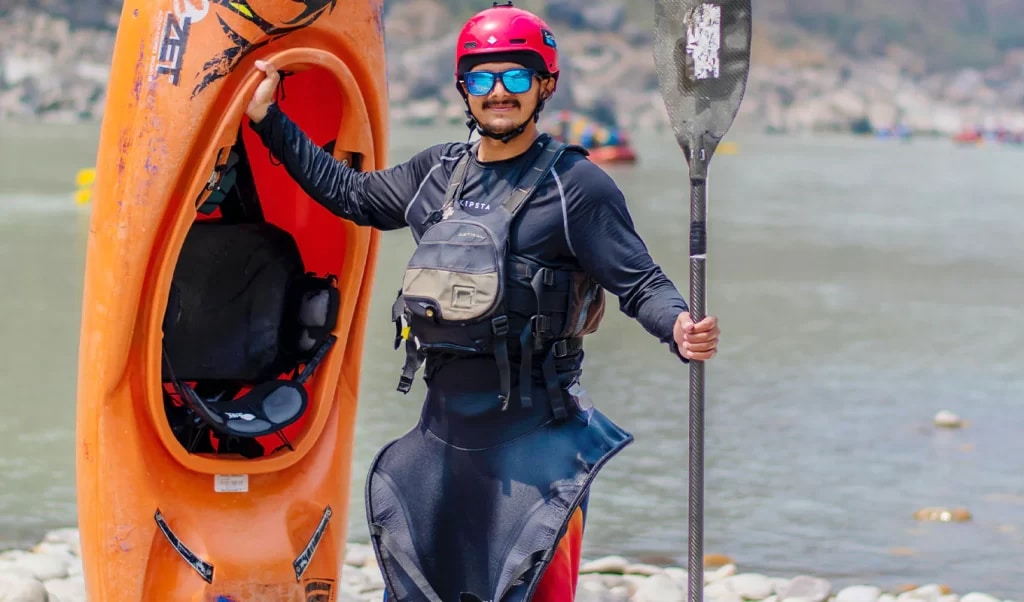Table of Contents
Having fun on your kayaking adventures is a good thing. Whether its ocean fishing in your kayak or just a casual day out. However, have you ever considered what to wear for kayaking? A base layer, a wetsuit, a warm dress for kayaking in winter conditions, what exactly? You don’t have to worry anymore; we have created a proper checklist for your perfect kayaking attire. Hence, you can just keep focusing on your kayaking outdoor adventures and not worry about what to wear when kayaking.

Wear for Kayaking
Prioritizing comfort, protection, and weather adaptability is essential when preparing for kayaking excursions. To keep yourself dry and warm, start with an appropriate base layer, ideally composed of moisture-wicking materials like merino wool or synthetic fabrics. The key is layering, which lets you adapt to changing water conditions or temperature swings. Wear a dry suit or wetsuit in chilly weather to stay warm and dry; wear light, breathable gear in warmer weather. Remember to always wear a personal flotation device or PFD for your protection.
Choose long-sleeved shirts to shield yourself from the sun, and choose paddling gloves to protect your hands. Steer clear of cotton since it retains water and can cause discomfort or even hypothermia in chilly weather. To protect your feet and offer traction, you must wear water shoes. Last, but not least, remember to include spray skirts or other accessories to keep water out of your kayak. You may ensure a pleasant canoeing experience by dressing appropriately and following these tips.

What to Wear for Kayaking: Guidelines
Now, selecting the appropriate clothing is essential for comfort, safety, and enjoyment when getting ready for a kayaking trip. Here are some of the guidelines you can follow for good kayaking outfits.
1. Always Wear a Personal Flotation Device (PFD)
When on the water, you should always wear a PFD. It’s an essential safety precaution that may save your life in an emergency.
2. Dress for the Water Temperature
When choosing clothes, consider the water temperature more than the air temperature. Wearing a wetsuit or dry suit could be necessary to stay warm and shielded from the cold water.

3. Layer Up
Wear layers of clothing to keep your body temperature at its ideal level. Begin with a base layer composed of materials such as polyester or nylon that drain away moisture quickly. Steer clear of cotton since it retains moisture after absorbing it, which can cause discomfort and even hypothermia in cold weather.
4. Sun Protection
Wear clothing with UPF-rated textiles to shield yourself from damaging UV radiation. Sun exposure when on the water can be significant, even on cloudy days. Remember to slather exposed skin in sunscreen as well. You must always remember what to wear when kayaking in summer.

5. Comfort and Mobility
Dress comfortably with ease, especially if you plan to spend a lot of time sitting in the kayak. Seek materials resistant to abrasion to survive the harsh conditions of kayaking, such as sand, water, and uneven surfaces.
6. Rust-Resistant Hardware
Choose equipment designed specifically for paddling made of rust-resistant materials, particularly for zippers, fasteners, and hardware. Rugged polymers are an alternative to metal parts, which can rust in saltwater settings.

7. Footwear: What Shoes to Wear While Kayaking
Wear sandals or water shoes that protect and grip your feet when kayaking. Avoid heavy shoes that could get soggy or limit your movement.
8. Women’s Concerns: What Kayaking Women Should Wear
Women should prioritize comfort and movement when choosing kayaking gear. Seek solutions for women’s fit, considering PFD padding and support.

9. Extra Accessories
Depending on the weather, you might also want to don a spray skirt to keep water out of the cockpit in stormy conditions and paddling gloves for increased protection and grip.
Follow these recommendations and dress appropriately to stay safe, comfortable, and ready for your kayaking experiences, regardless of the weather, whether it’s balmy summertime or freezing winter. Always put safety first, and be ready for any changes in the weather or sea conditions.

Kayaking in a Wetsuit
Layering carefully is essential when kayaking in a wetsuit to guarantee comfort and safety on the water. A wetsuit protects from the elements and insulation in cold water situations. Choosing non-cotton for the base layer is advisable to prevent water absorption. Whichever paddle wear is selected, wearing a personal flotation device, or PFD, is a must for safety.
A short- or sleeveless wetsuit with a quick-dry top provides flexibility and sun protection during warm weather. But it’s crucial to be ready for shifting weather by packing extra layers, such as a lightweight fleece jacket and a rain jacket, in case you need to protect yourself from windchill.
A dry suit is a good option for kayaking excursions in cooler climates. Layering with non-cotton long underwear and a thick fleece mid-layer ensures warmth, while the dry suit offers wind and waterproof protection. Other vital things to consider include sun protection, water shoes, spray skirts, and paddling gloves for a safe and comfortable trip on the water.

Final Thoughts on Kayaking What to Wear
Finally, it’s critical to consider comfort, safety, and weather protection for kayaking outfits. Starting with a base layer that takes away moisture is important, especially in cold waters. Wear a personal flotation device (PFD) at all times, and choose paddling clothing that allows unrestricted movement while offering insulation. Life jackets are essential for any kayaking activity. Investing in a dry suit can guarantee warmth and dryness in colder weather. Prioritize sun protection when the temperature rises by wearing long sleeves and lots of sunscreen, and choose light, breathable clothing.
Moreover, as we discussed above, water shoes provide traction and foot protection, while paddling gloves protect hands and improve grip. Avoid cotton clothing, as it absorbs water and might cause soreness or even hypothermia. In cold weather, outer layers that are windproof and waterproof are vital for staying warm and dry.
In conclusion, wearing the right clothing ensures a safe and enjoyable time on the water when kayaking, whether in the summer or the winter.
